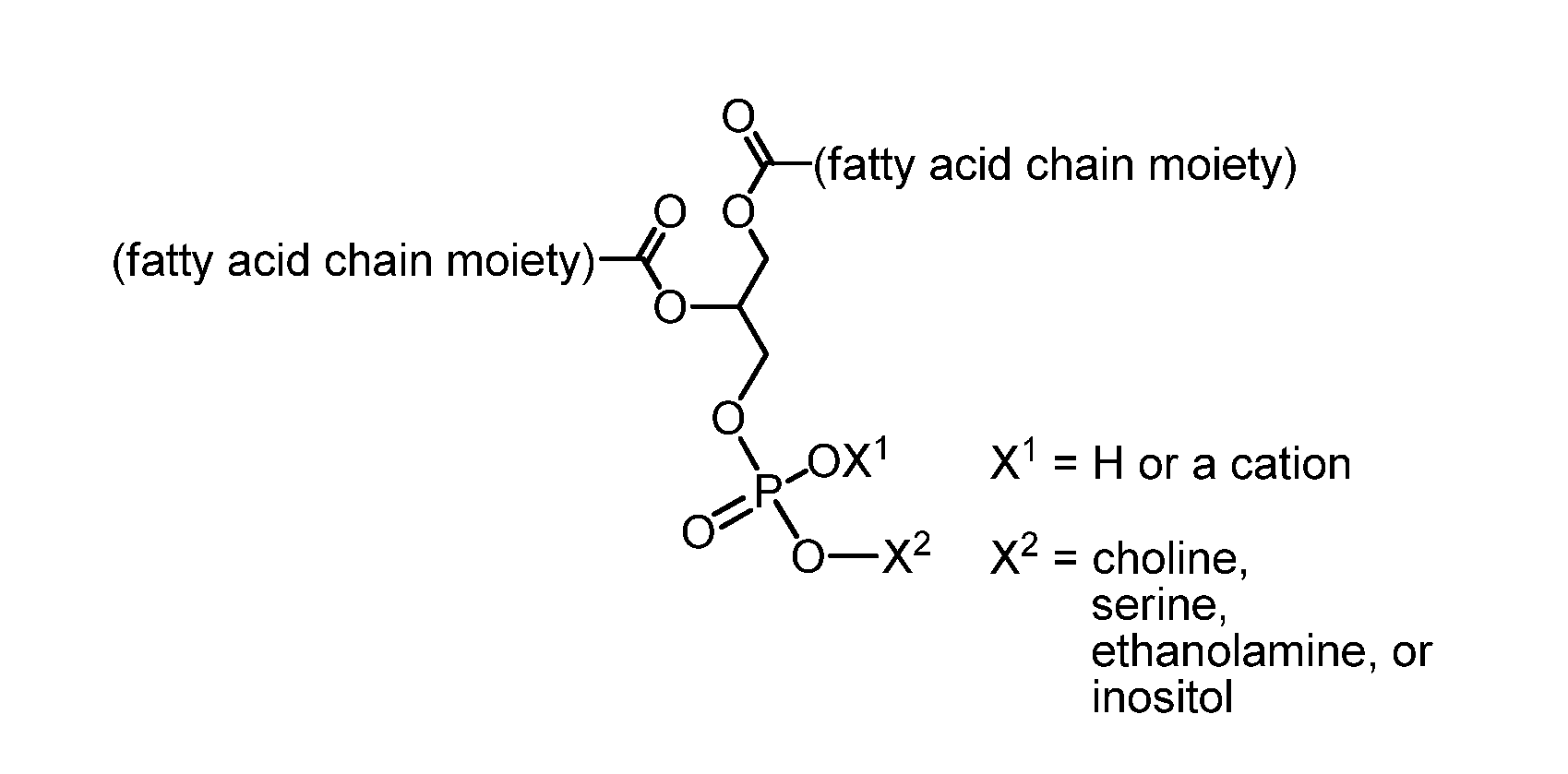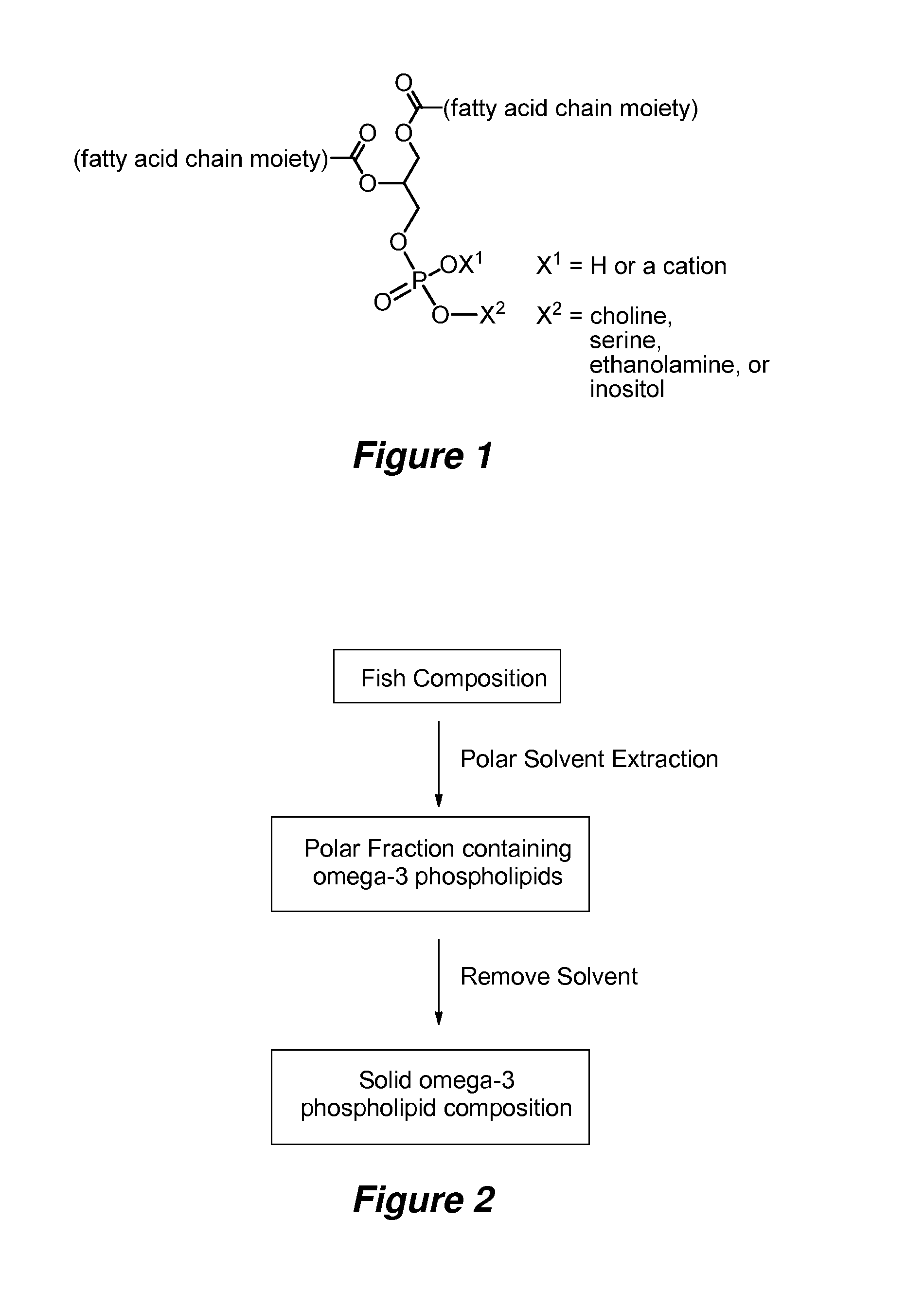Lipid compositions with high DHA content
a technology of lipid compositions and dha, applied in the direction of aerosol delivery, phosphorous compound active ingredients, metabolic disorders, etc., can solve the problems of inefficient processing by the body, seasonal variability in the amount of epa and dha, and inability to convert ala into epa and dha, etc., to achieve stable oxidation and provide oxidative stability
- Summary
- Abstract
- Description
- Claims
- Application Information
AI Technical Summary
Benefits of technology
Problems solved by technology
Method used
Image
Examples
example 1
Extraction of Phospholipids
[0152]Frozen, immature herring roe was ground and vacuum dried. The dried material was extracted with 96% ethanol at a ratio of 10 liters of ethanol per kg of dried roe in a stirred reactor at ambient temperature for 30 minutes. The stifling inside the reactor was combined with an external loop via a Silverson high shear mixer to break egg shells during the extraction. The solids and liquid extract were separated with a decanter. The solids were re-extracted with 96% ethanol, approximately 6 liters of ethanol per kg of dry weight eggs, for another 30 minutes. The solids and liquids were again separated in a decanter. The combined liquids (extracts) had a lipid content of around 5 wt. %, as determined by evaporation of volatiles from a sample using a rotary evaporator under reduced pressure. The lipid fraction was then concentrated by ethanol evaporation until reaching approximately 12% in a falling film evaporator at a temperature of less than 50° C. The l...
example 2
Analysis of Phospholipid Composition Content
[0153]Extracted phospholipid compositions were in the form of a solid PL wax, which were analyzed for phospholipid mass balance and fatty acid content. The phospholipid compositions can be about 50% to about 95% phospholipids by weight. With further purification, the compositions can be about 90 wt. % to about 100 wt. % phospholipids. As can be observed from Table 2-1 below, phosphatidylcholine forms a large percentage of the phospholipid composition (e.g., a PL wax or a PL oil), for example, at least about 40 wt. %, at least about 50 wt. %, or at least about 54 wt. %. The composition also includes at least about 5 wt. %, or at least about 6 wt. % phosphatidylethanolamine. Table 2-1 uses standard abbreviations including APE for acyl phosphatidylethanolamine.
TABLE 2-1Typical PL species as quantified by NMR.PL-classNo of FAsMWTypical weight % of PL waxPC281255.01-LPC1534.50.42-LPC1534.52.7PI29070.8PE27706.5LPE1492.50.4APE310320.3other28120.2...
example 3
Phospholipid Composition PL30 and PL50
[0162]The phospholipid compositions obtained as descried in Example 1 can be conveniently blended with a carrier such as a fish oil, for example, having a 17:54 EPA:DHA ratio, to provide a MOPL. A blend containing a minimum of 30 wt. % polar lipids is herein referred to as PL30, typically made by mixing wax and fish oil carrier approximately 50:50. A blend containing 50 wt. % polar lipids is herein referred to as PL50, typically made by mixing wax and fish oil carrier approximately 80:20. Ash content, primarily minerals, can comprise about 4-5 wt. % of the composition.
[0163]The PL30 and PL50 lipid compositions were further analyzed to determine their density, viscosity, flash points, and pour points. The data obtained is shown in the table below.
TestPL30PL50Density @ 20° C. (g / cm3)0.981.01Density @ 50° C. (g / cm3)0.960.98Kinematic Viscosity @ 20° C. (mm2 / s)111.9*Kinematic Viscosity @ 50° C. (mm2 / s)33.29*Flash Point, PMCC (° C.)130.055Pour Point (...
PUM
| Property | Measurement | Unit |
|---|---|---|
| Fraction | aaaaa | aaaaa |
| Weight | aaaaa | aaaaa |
| Fraction | aaaaa | aaaaa |
Abstract
Description
Claims
Application Information
 Login to View More
Login to View More - R&D
- Intellectual Property
- Life Sciences
- Materials
- Tech Scout
- Unparalleled Data Quality
- Higher Quality Content
- 60% Fewer Hallucinations
Browse by: Latest US Patents, China's latest patents, Technical Efficacy Thesaurus, Application Domain, Technology Topic, Popular Technical Reports.
© 2025 PatSnap. All rights reserved.Legal|Privacy policy|Modern Slavery Act Transparency Statement|Sitemap|About US| Contact US: help@patsnap.com



